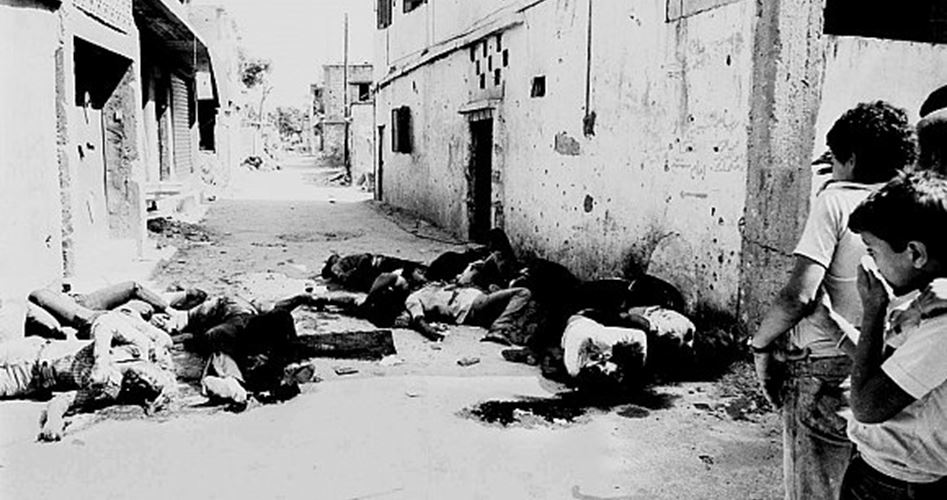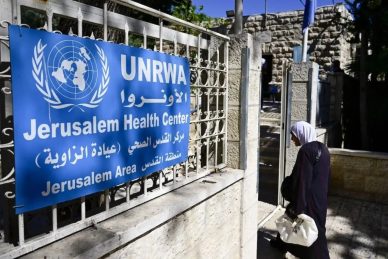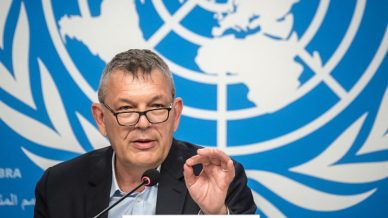Saturday 16 September 2017 marks the 35th anniversary of the massacre of Sabra and Shatila in the Sabra and Shatila refugee camps in Lebanon in 1982.
On that day the world woke up to what seemed to an irreparable wound for the Palestinians. The world woke up to one of the most heinous massacres in the history of mankind against the Palestinians to slaughtered bodies without heads eyeless heads and broken bones.
The massacre against the people of the two camps continued for three days from 16 to 18 September during which many martyrs including men children women and elderly unarmed civilians mostly Palestinians were murdered. Two thousand martyrs were murdered of the 20000 inhabitants of Sabra and Shatila at the time of the massacre.
The massacre began after the Israeli army led by the then Minister of Defense Ariel Sharon and his chief of staff Rafael Eitan surrounded the refugee camps and facilitated entry of Lebanese Christian militias to commit the massacre with complete media blackout. They used knives and other weapons in the killings. The Israeli army besieged the camp and lit it at night to facilitate the bloodbath.
Only children elderly and women were in the besieged camps. The Lebanese gunmen killed women and children in cold-blood. Most of the bodies were strewn in the streets of the camp and then bulldozers entered the camp to demolish the houses and hide the crime.
The massacre was carried out in revenge from the Palestinians who stood up to the Israeli war machine following three months of siege which ended with international guarantees to protect the unarmed inhabitants of the camps after the Palestinian resistance fighters left Beirut but the broker states did not fulfill their obligations and abandoned the innocent people of the camps leaving them to be killed or wounded.
The massacre aimed at spreading terror in the hearts of the Palestinians urging them to migrate outside Lebanon fueling internal strife there and completing the 1982 Israeli invasion of Lebanon which targeted the Palestinian presence there and to incite the Palestinians against their leadership at the pretext that they left Lebanon and left them without protection.
The carnage in Sabra and Shatila was not the first Israeli massacre against the Palestinian people and it was not the last. It was preceded by the massacres of Qubiya Deir Yassin and Al-Tantura and followed by the Jenin and the Gaza massacres and other massacres. Despite the big number of deaths and the way civilians were murdered the perpetrators are still at large.
Sabra and Shatila
Sabra is an administrative district of Al-Ghubairi municipality in the governorate of Mount Lebanon bordered by the city of Beirut to the north the sports city to the west the tombs of martyrs and Qusqas from the east and Shatila camp from the south.
The Sabra neighborhood is home to a large number of Palestinians but it is not a refugee camp officially although its name is associated with Shatila which creates the impression that it is a camp.
The name belongs to the family of Sabra which the street that passes through the heart of the neighborhood was named after starting from the neighborhood of Dana in the New Road of Beirut and passing through the Sabra square and the main vegetable market and ending at the entrance of Shatila camp.
Shatila is a Palestinian refugee camp established by the United Nations Relief and Works Agency for Palestine Refugees in the Near East (UNRWA) in 1949 to house hundreds of refugees who poured into it from the villages of Amqa Majd Al-Krum and Yajour in northern Palestine after 1948.
The camp is located to the south of Beirut the capital of Lebanon. Months after the Nakba and as the demand for housing increased Saad Eddin Pasha Shatila donated a land to build a refugee camp on it which became known since then as the Shatila camp.
Half of the land of the camp belongs to the Palestine Liberation Organization while UNRWA rents the other half. The camp is known to be the site of the Sabra and Shatila massacre in September 1982 in addition to the 1982 Lebanese Civil War and the Camps War between 1985 and 1987.
The area is one square kilometer and is home for more than 12000 refugees. The camp is one of the most densely populated areas with only two schools and one medical center.
The environmental health of the camp suffers from severe shortages; houses are damp and overcrowded many have open drains and the camp’s drainage system needs to be expanded.
The events of the massacre
The decision to commit the massacre was made by Rafael Eitan the Chief of Staff of the Israeli army and Ariel Sharon then the Minister of Defense in Menachem Begin’s government during which the occupation army allied with the Lebanese Phalange Party to write a bloody page of injustice and oppression in its history.
On the morning of September 16 1982 the refugees of Sabra and Shatila camps woke up to one of the bloodiest chapters in the history of the Palestinian people and maybe to one of the ugliest massacre in the history of the entire world against resistance and liberation movements.
Three armed groups each consisting of 50 armed men entered the camp. The Lebanese Maronite groups surrounded the inhabitants of the camp killing civilians relentlessly.
The camp was completely encircled by the South Lebanon Army and the Israeli army. The Lebanese militias committed the massacre inside the camps while the Israeli army provided protection and ordered civilians who tried to leave the camps to go back.















